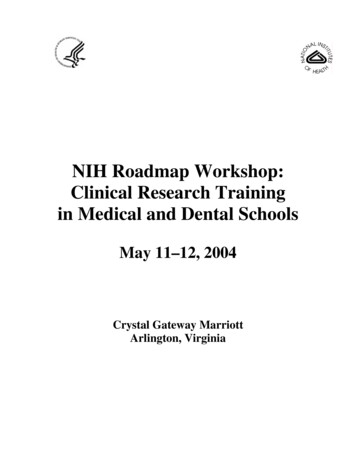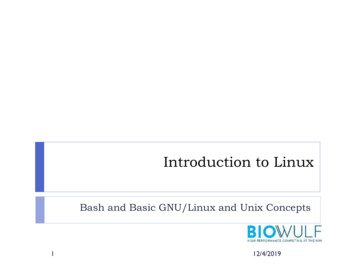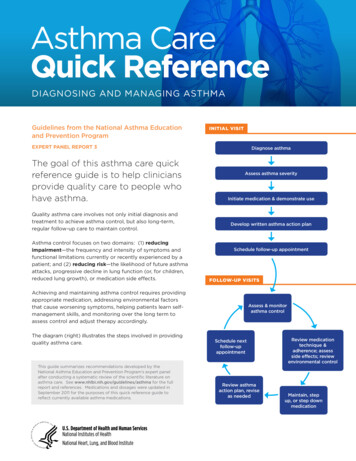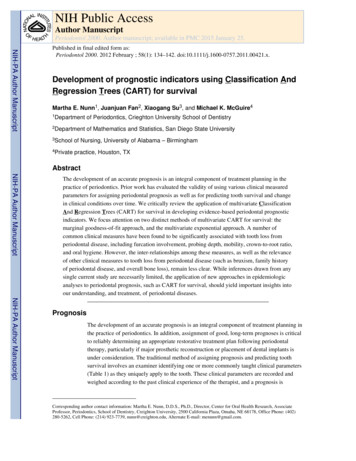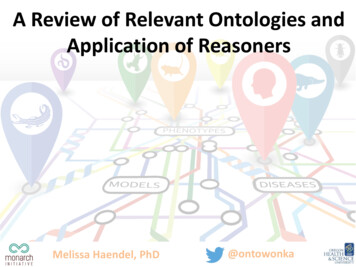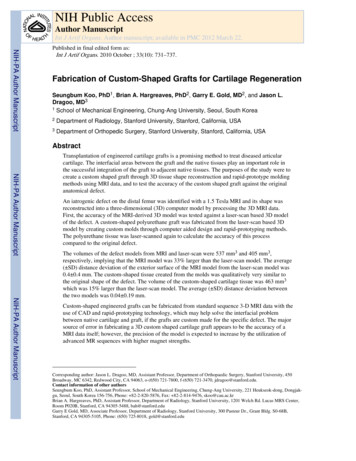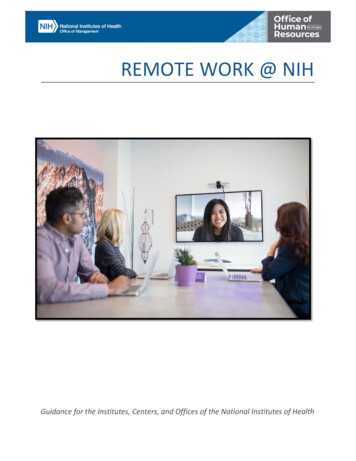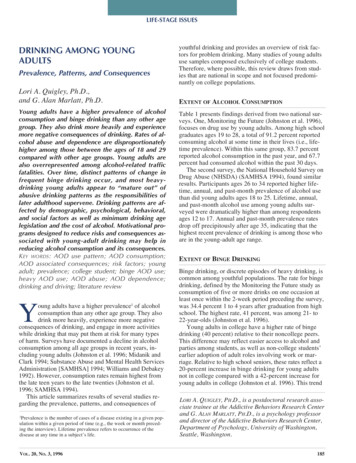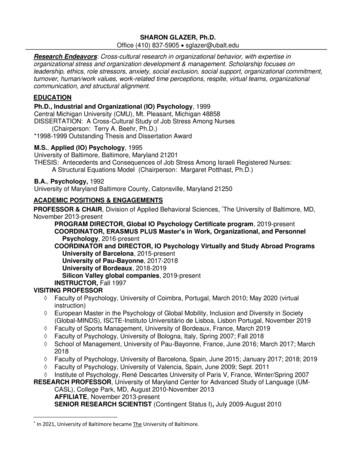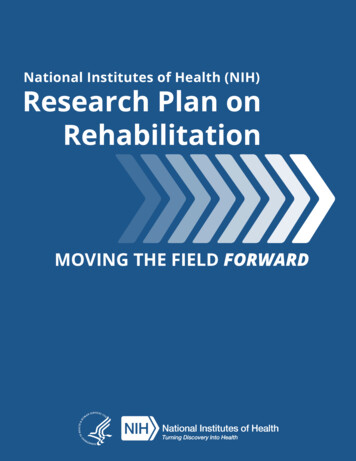
Transcription
National Institutes of Health (NIH)Research Plan onRehabilitationMOVING THE FIELD FORWARD
National Institutes of HealthResearch Plan on Rehabilitation2016U.S. Department of Health and Human ServicesNational Institutes of HealthDeveloped by the Eunice Kennedy Shriver National Institute of Child Health andHuman Development and the NIH Medical Rehabilitation Coordinating Committee
Table of ContentsExecutive Summary. 4Introduction . 6The Need for Rehabilitation Research . 6NIH’s Investment in Rehabilitation Research . 7Current Medical Rehabilitation Research Activities at NIH . 8Extramural Research . 9Intramural Research. 9Opportunities, Needs, and Priorities . 14A: Rehabilitation Across the Lifespan . 14Objectives. 15B: Community and Family . 16Objectives. 16C: Technology Use and Development. 16Objectives. 17D: Research Design and Methodology. 18Objectives. 18E: Translational Science . 18Objectives. 19F: Building Research Capacity and Infrastructure. 19Objectives. 20Coordination with Other Federal Agencies . 20Department of Defense (DoD) . 21Joint Program Committee-8/Clinical and Rehabilitative MedicineResearch Program (JPC-8/CDMRP). 21Defense Advanced Research Projects Agency (DARPA) . 21Department of Health and Human Services (HHS) . 21Agency for Healthcare Research and Quality (AHRQ) . 21Centers for Disease Control and Prevention (CDC) . 22
Page 3Food and Drug Administration (FDA). 22National Institute on Disability, Independent Living, and Rehabilitation Research (NIDILRR). 22National Science Foundation (NSF). 23Department of Veterans Affairs (VA). 23Conclusion. 24Appendix A: References. 26Appendix B: Participating Institutes and Centers . 29NIH Institutes . 29NIH Centers . 29
Page 4Executive SummaryMillions of Americans have a disability so severe that they have difficulty with everyday tasks such asgoing to work or taking care of themselves. Some have been injured in accidents or war. Some wereborn with their disability. Some have developed disabilities over time.Rehabilitation research explores the intricate biology of disabilities and looks for ways to help restorelost function and to help people with disabilities reach their full potential.The National Center for Medical Rehabilitation Research (NCMRR) within the Eunice Kennedy ShriverNational Institute of Child Health and Human Development of the National Institutes of Health (NIH)coordinates federal medical rehabilitation research. NCMRR has led the effort to release the NIHResearch Plan on Rehabilitation.This 5-year plan lays out priorities in medical rehabilitation research; will guide NIH support forrehabilitation medicine; and will benefit individuals with temporary or chronic limitations in physical,cognitive, or sensory function that require rehabilitation.The plan was submitted for public comment in October 2015. The National Advisory Board on MedicalRehabilitation Research (NABMRR) reviewed the public comments in December 2015, and the NABMRRprovided a second review of the revised objectives in May 2016. The final public input was receivedthrough the Town Hall meeting held during the May 2016 conference “Rehabilitation Research at theNIH: Moving the Field Forward.”The plan addresses the following topics: The Need for Rehabilitation ResearchNIH’s Investment in Rehabilitation ResearchCurrent Medical Rehabilitation Research Activities at NIHOpportunities, Needs, and PrioritiesCoordination with Other Federal AgenciesThe Need for Rehabilitation Research. Disability casts a long shadow over the United States. Accordingto the Centers for Disease Control and Prevention about 53 million people have a disability—1 in5 Americans; estimates from the Census Bureau are relatively similar with estimates of disability,56.7 million Americans. People with disabilities are more likely to have health problems, but they have aharder time getting to a health care provider. Meanwhile, more than 43 million people in the UnitedStates are caregivers to people with disabilities, and their health also may suffer.NIH’s Investment in Rehabilitation Research. Many more professionals are now entering the field ofrehabilitation research, thanks in part to NIH investment in rehabilitation research training. NIH has alsofunded the development of new mobility devices, rehabilitation techniques and interventions, andstudies of the body’s self-repair mechanisms in hopes of better harnessing those mechanisms.
Page 5Current Medical Rehabilitation Research Activities at NIH. In fiscal year 2015, NIH awarded 514 million to support rehabilitation research conducted by investigators in universities, nonprofitinstitutions, and small businesses. The funding has stimulated many advances, including in braincomputer interface systems. These systems can restore communication and control to people paralyzedor “locked in” by amyotrophic lateral sclerosis or other neuromuscular disorders.Opportunities, Needs, and Priorities. Rehabilitation research runs wide and deep within NIH. SeventeenInstitutes and Centers fund rehabilitation research. This research plan helps coordinate those effortsand focuses on six areas of rehabilitation research: rehabilitation across the lifespan, family andcommunity, technology use and development, research design and methodology, translational science,and building research capacity and infrastructure.Coordination with Other Federal Agencies. NIH also coordinates the funding of rehabilitation researchwith other federal agencies to ensure the best use of federal dollars. NIH coordinates with the NationalInstitute on Disability, Independent Living, and Rehabilitation Research and the Department of VeteransAffairs, among others. These agencies attend regular meetings together, including meetings of theNABMRR and the Interagency Committee on Disability Research.Much progress has occurred since NIH released its first rehabilitation research plan in 1993. We havemore rehabilitation researchers because of funding given to training programs. We have new and moreadvanced mobility devices and a deeper understanding of how the body’s repair mechanisms work, andwe know better how to apply that understanding to improve outcomes.This research plan provides a framework to continue that work and to give all individuals, whatever theirabilities and disabilities, the chance to live to their full potential.
Page 6IntroductionTHE NEED FOR REHABILITATION RESEARCHAbout 53 million to 57 million Americans—about 1 in 5, or 22.2 percent of adults—have a disability ofsome kind (Courtney-Long et al., 2015; Brault, 2012). About 33 million Americans have a disability thatmakes it difficult for them to carry out daily activities, ranging from attending school or work to dailyphysical care. Approximately 2.2 million people in the United States depend on a wheelchair for day-today tasks and mobility; additionally, 6.5 million people use a cane, a walker, or crutches. Cognitivedisability is frequently cited as a disability, with 15.2 million Americans estimated to have difficulty withmental or emotional functioning (6 percent). Disabilities associated with sensory abilities arewidespread. About 36 million American adults (17 percent) report having some degree of hearing loss;nearly one-half of adults ages 75 years and older have hearing loss. About 3.6 million Americans havevisual impairment, and more than 1 million of them are legally blind. Nearly 7.5 million people in theUnited States have trouble using their voices, and between 6 million and 8 million people in the UnitedStates have some form of language impairment.When setting national health priorities as part of the Healthy People 2020 initiative, the Department ofHealth and Human Services documented that individuals with disabilities are more likely to experiencehealth disparities (Peacock et al., 2015). They are more likely to experience delays or difficulties inaccessing health care, have fewer preventive tests or procedures (e.g., Pap tests or mammograms),spend less time on fitness activities, and have higher rates of tobacco use and obesity than the generalpopulation. Although the Agency for Healthcare Research and Quality (AHRQ) found a high rate ofimprovement in quality indicators for health care in those without disability over a 10-year period, only20 percent to 35 percent of these quality indicators improved for individuals with activity limitations(AHRQ, 2015).Disability affects not only those who experience these challenges firsthand but also those who supportor care for people with disabilities. Based on a 2015 study, American Association of Retired Persons(AARP) estimates that the United States is home to approximately 43.5 million caregivers (AARP, 2015).Most caregivers are adults age 50 and older. People who provide care can experience emotional stress,poor health, decreased opportunity to work, financial strain, and decreased ability to participate insocial or community roles.The extent of disability in the United States and its widespread public health impact on those withdisabilities and their families and communities requires a response aimed at improving function, activity,and participation for these people with disabilities. The primary aims of rehabilitation research at theNational Institutes of Health (NIH) are to improve rehabilitation and habilitation approaches forindividuals with disabilities and to gain knowledge about the underlying diseases that cause disability.For the purpose of this plan, rehabilitation research includes the study of mechanisms, interventions,and methods that improve, restore, or replace lost, underdeveloped, or deteriorating function forpeople with disabilities in the context of their environment. Function includes a person’s use of bodysystems, ability to complete activities and participate in society, and satisfaction with their quality of life.
Page 7Rehabilitation research faces a number of challenges that have parallels in other areas of medicine.Those who could benefit from the research have limitations in transportation, mobility, finances, andaccess to information that can interfere with their participation in studies. These factors place significantlimitations on researchers’ ability to conduct appropriately powered studies. Outcome metrics rely onmore subjective self-report and individual clinician measurement that can vary over time. Althoughevidence-based therapy is urgently needed, conducting a tightly controlled study can be difficult. Findinga well-matched comparison group for the treatment group poses significant challenges. Masking thetreatment and control conditions, which is useful to ensure an impartial analysis of the results, can beproblematic. Despite incredible progress over the past 20 years, new directions and challenges areapparent and underlie the need for new priorities to drive rehabilitation science.NIH’S INVESTMENT IN REHABILITATION RESEARCHThe Americans with Disabilities Act and the subsequent Public Law 101-613, National Institutes ofHealth Amendments of 1990, provide for the establishment of the National Center for MedicalRehabilitation Research (NCMRR) in the Eunice Kennedy Shriver National Institute of Child Health andHuman Development (NICHD), part of NIH. NCMRR’s mission is to reduce disability by conducting andsupporting research and research training in medical rehabilitation. The establishing legislation requiresNIH to develop a comprehensive research plan for rehabilitation that encompasses: (1) current medicalrehabilitation research activities conducted or supported by the federal government; (2) opportunitiesand needs for additional research, and priorities for such research; (3) recommendations for thecoordination of such research conducted or supported by NIH and other federal government agencies.In 1993, NCMRR published its first research plan for rehabilitation, which guides development of andsupport for rehabilitation research at NIH. The 1993 research plan included a conceptual model ofdisability that incorporated scientific principles and social values. It used a systems approach to medicalrehabilitation, with the individual at the center of the rehabilitation process. It encompassed personalbackground factors (organic, psychosocial, and environmental factors) and quality of life factors(survival, productivity, and social and work relationships) that influence the course and outcome ofrehabilitation for individuals who require services at different points in their lives. Recognizing thatrehabilitation research was an emerging science and that the research capacity was still relatively weakcompared to other biomedical areas and disciplines, NIH suggested that research initiatives and fundingopportunities to advance the science of medical rehabilitation were needed in seven general categories:mobility; behavioral adaptation; whole body system response; technical devices; measurement,assessment, and epidemiology; treatment evaluation; and training of research scientists.Since NCMRR published the first research plan, significant progress has occurred in the rehabilitationresearch field. NIH’s investment in rehabilitation training programs in multiple rehabilitation-focuseddisciplines has led to an increase in the number of people entering the field of rehabilitation research.Through NIH investment in research infrastructure networks, the field has gained access to consultation,training, education, and small pilot grant opportunities in fields as diverse as simulation research,neuromodulation, commercialization, analysis of publicly available data, and genomics and otherindividual markers of rehabilitation intervention and outcome. NIH supported the development of new
Page 8mobility devices, rehabilitation techniques and interventions, and studies of the underlying mechanismsthat support plasticity and repair.In 2012, the Director of NIH convened a Blue Ribbon Panel (BRP) on Medical Rehabilitation Research toassess the state of rehabilitation research at NIH and determine how NCMRR and NIH can catalyze andsupport rehabilitation research across the agency. To meet the growing rehabilitation needs ofAmericans with physical disabilities, the BRP made several recommendations for the field ofrehabilitation research: (1) define rehabilitation research; (2) develop a research plan that includes atrans-NIH strategic plan to tackle rehabilitation problems; (3) increase the clinical and societal relevanceof NIH’s rehabilitation research by addressing the gaps in translational research and the World HealthOrganization’s International Classification of Functioning, Disability, and Health framework; (4)substantially increase funding for all aspects of translational rehabilitation research; (5) continue to buildresearch capacity; and (6) increase participation of persons with disabilities and public advocates in thedevelopment and implementation of all rehabilitation research.In 2015, NCMRR, the NIH Medical Rehabilitation Coordinating Committee (MRCC), and the NationalAdvisory Board on Medical Rehabilitation Research (NABMRR) initiated an update to the 1993 plan. Thenew plan, presented here, is built upon progress made over the past 2 decades, especially an increasedcapacity to take on new research efforts that address remaining and new challenges in the field. Toupdate and inform the 2016 Research Plan on Rehabilitation, the NIH community looked first to theNABMRR to recommend current priority areas, to explore plans of action, and to formulate ways inwhich NIH could build capacity in the workforce and infrastructure that support rehabilitation research.Following this consultation, the MRCC worked to draft tangible priorities and objectives that areapplicable across all of NIH and are consistent with the NIH mission: “to seek fundamental knowledgeabout the nature and behavior of living systems and the application of that knowledge to enhancehealth, lengthen life, and reduce illness and disability.” The plan presented below represents anintegrated and comprehensive vision from stakeholders across NIH.
Institutes and Centers fund rehabilitation research. This research plan helps coordinate those efforts and focuses on six areas of rehabilitation research: rehabilitation across the lifespan, family and community, technology use and development, research design and methodology, translational science,File Size: 443KB
